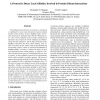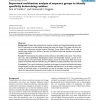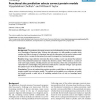69 search results - page 7 / 14 » Prediction of the Number of Residue Contacts in Proteins |
BMCBI
2008
13 years 7 months ago
2008
Background: A multiple sequence alignment (MSA) generated for a protein can be used to characterise residues by means of a statistical analysis of single columns. In addition to t...
CPM
2004
Springer
14 years 26 days ago
2004
Springer
In this paper we investigate the protein sequence design (PSD) problem (also known as the inverse protein folding problem) under the Canonical model 4 on 2D and 3D lattices [12, 25...
BIBM
2007
IEEE
13 years 11 months ago
2007
IEEE
The tridimensional structure of a protein is constrained or stabilized by some local interactions between distant residues of the protein, such as disulfide bonds, electrostatic i...
BMCBI
2007
13 years 7 months ago
2007
Background: Proteins that evolve from a common ancestor can change functionality over time, and it is important to be able identify residues that cause this change. In this paper ...
BMCBI
2008
13 years 7 months ago
2008
Background: The prediction of protein structure can be facilitated by the use of constraints based on a knowledge of functional sites. Without this information it is still possibl...



